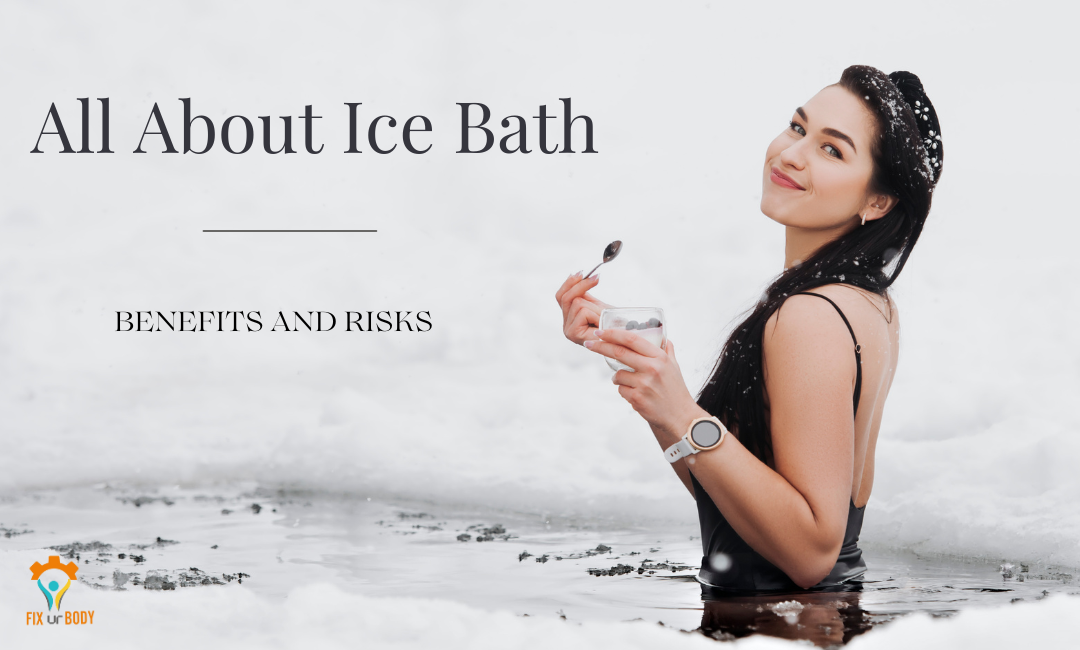Ice hack trends are leading nowadays. The Ice Bath Therapy, also known as Cold Water Immersion (CWI), has sparked considerable interest in sports and wellness. Let’s explore what contemporary research reveals about this chilly practice.
Investigating the Latest Findings on This Ice Hack
Recent studies have questioned the efficacy of ice baths in muscle recovery. Studies only partially negated the benefits and then suggested a need for further investigation. Experts now emphasize the ongoing relevance of this ice hack in certain scenarios.
Unpacking the Advantages of Cold Water Immersion – The Trendy Ice Hack
Ice baths, or cold water immersion (CWI), are widely used in sports and fitness for various benefits. While empirical evidence varies, many athletes and researchers have reported positive outcomes. Here’s a deeper look at the advantages of this ice hack:
1. Muscle Soreness Relief:
Example: Athletes, particularly those in high-intensity sports like football or track and field, often use ice baths after training sessions or competitions. For instance, marathon runners have been known to use CWI to alleviate post-race soreness.
Evidence: A study published in the “Journal of Physiology” reported that CWI helped reduce muscle soreness in 40% of participants compared to rest or no intervention. This relief is attributed to the numbing effect of the cold, which can reduce the perception of pain.
2. Enhancement of the Central Nervous System (CNS):
Example: Professional swimmers or triathletes use this ice hack to enhance recovery. This includes not just physical recovery but also improvements in sleep quality and overall CNS recovery, which is crucial for athletes who train multiple times a day.
Evidence: Research indicates that CWI can help reduce fatigue and improve sleep quality. A study in the “European Journal of Applied Physiology” found that CWI helped athletes sleep better, which is critical for CNS recovery and next-day performance.
3. Reduced Inflammation:
Example: Team sports athletes, like those in rugby, often use CWI post-game to manage inflammation caused by physical collisions and intense exertion.
Evidence: A systematic review in the “Scandinavian Journal of Medicine & Science in Sports” found that CWI was effective in reducing markers of muscle damage and inflammation.
4. Mitigating Effects of Heat:
Example: Athletes competing in hot climates, such as runners or cyclists in summer events, might use ice baths to lower their core body temperature beforehand, potentially improving endurance and performance.
Evidence: A study in the “Journal of Science and Medicine in Sport” suggested that pre-cooling with ice baths could improve endurance performance in the heat.
5. Strengthening the Vagus Nerve:
Example: Endurance athletes, who often face stressful situations and require efficient stress management, may benefit from the vagus nerve strengthening effects of regular CWI.
Evidence: The benefits of CWI on the vagus nerve, and consequently on stress resilience, are more anecdotal and derived from the broader research on cold exposure. Cold exposure is known to activate the parasympathetic nervous system (of which the vagus nerve is a key part), helping the body to relax and recover post-stress.
While the evidence supporting these benefits varies in its conclusiveness, the anecdotal and reported experiences from athletes and fitness enthusiasts provide a compelling case for the use of this ice hack in certain contexts. However, it’s important to note that individual responses to CWI can vary greatly, and what works for one athlete may not work for another. Additionally, anyone considering ice baths should be aware of potential risks and consult with a healthcare professional, especially if they have pre-existing health conditions.
Understanding the Potential Drawbacks of Ice Baths
While there are benefits, it’s crucial to be aware of the risks of this ice hack:
- Initial Discomfort:
- The shock of this ice hack can be quite intense, especially for those not accustomed to it. This can trigger a ‘cold shock response,’ which includes involuntary gasping and hyperventilation, increasing the risk of drowning if the person is not careful or supervised.
- For those with sensory processing disorders or certain neurological conditions, this sudden and intense cold sensation can be overwhelming or distressing.
- Note that: This cold shock response is the reason of all the benefits (burning fat, fixating your mood and emotions, etc…). And, you will never get used to it with time and stop feeling it, so hang on there 🙂
- Cardiovascular Concerns:
- Cold water causes blood vessels to constrict (vasoconstriction), which can increase blood pressure and strain on the heart. People with existing heart conditions, hypertension, or circulatory issues may be at a higher risk of adverse cardiovascular events, such as heart attacks or strokes.
- For older adults or those with atherosclerosis, the increased cardiovascular strain could be particularly risky.
- Risk of Hypothermia:
- Prolonged immersion in cold water can lower body temperature too much, leading to hypothermia. Symptoms include intense shivering, slurred speech, drowsiness, and confusion, and in severe cases, it can be life-threatening.
- Those with a lower body fat percentage or smaller body size, such as children, are at higher risk of hypothermia due to less natural insulation.
- Diabetes Precautions:
- People with diabetes may have impaired nerve function (neuropathy) and may not fully perceive extreme temperatures, increasing the risk of frostbite or hypothermia.
- Diabetes can also affect blood flow, making it more challenging for the body to regulate its temperature in response to extreme cold in this ice hack.
- Pregnancy Considerations:
- For pregnant women, extreme temperatures, either hot or cold, are generally advised against. The potential stress and strain from cold water immersion could negatively impact both the mother and the developing fetus.
- There’s also a theoretical risk that the stress response from cold exposure could lead to uterine contractions, though direct evidence is limited.
- Concerns for Babies and Children:
- Babies and young children have a higher surface area to volume ratio and less developed regulatory mechanisms for their body temperature, making them more susceptible to temperature extremes.
- Their skin is also more sensitive, increasing the risk of cold-related skin injuries. Moreover, the potential shock and stress of cold immersion are not recommended for babies.
Given these considerations, it’s clear that ice hack baths are not suitable for everyone and should be approached with caution, especially by individuals in these sensitive groups. It’s always best to consult with a healthcare provider before starting any new health regimen, particularly one involving extreme temperatures like ice baths.
Watch Out For Scams
Be aware! I myself like to follow up on the trends and challenge myself to prove that I am capable of achieving what other influencers are doing. However, the problem is that some ‘others’ provide fraudulent information on their social platforms. Social media today is all about followers, likes, and views, meaning that those people don’t care if the ‘hit’ video they have contains accurate content or not; they just want the reach.
One thing I saw that is trending lately is influencers challenging themselves to stay more in the ice tubs/ice baths. Also, some naive individuals just accept a challenge from someone sitting behind the screen, lacking knowledge, and just commenting. For example: “I challenge you to stay in freezing water for over 10 minutes.”
This is dangerous and might negatively affect your brain! So watch out and don’t believe everything you see cause your health is your priority.
Best Practices for Cold Water Immersion
To ensure a safe and effective ice hack bath experience, follow these tips:
- Optimal Temperature: Keep the water between 10–15°C (50–59°F).
- Time Management: A duration of 3-6 minutes is ideal.
- Incremental Immersion: Start with feet and legs before fully submerging.
- Home Setup: Use a thermometer to adjust the water to the right temperature.
- Prompt Timing: The sooner you immerse post-exercise, the better.
- Alternative Methods: Consider the Hunter Reaction/Lewis Reaction cycle for a less intense approach.
- Cryotherapy Options: Full-body cryotherapy offers a modern, though more expensive, alternative.
Ice Hack and Weight Loss – What’s The Genuine Relation
The relationship between ice baths and weight loss is an area of emerging interest and research. While ice baths are primarily known for their benefits in muscle recovery and reducing inflammation, as explained above, there is some evidence to suggest that exposure to cold temperatures can influence weight loss and metabolism in several ways:
- Activation of Brown Fat: Humans have two types of fat tissue – white fat and brown fat. Brown fat burns calories to generate heat. Exposure to cold temperatures, like those experienced during an ice bath, can stimulate brown fat activity, leading to increased calorie burning. However, the overall impact on weight loss from activating brown fat through cold exposure is still a subject of ongoing research.
- Increased Metabolic Rate: Exposure to cold can increase the body’s metabolic rate as it works to maintain its core temperature. This process can lead to more calories being burned, which theoretically could contribute to weight loss. However, this effect might be relatively small and not sufficient as a primary weight loss strategy.
- Hormonal Effects: Cold exposure can influence the levels of certain hormones that are involved in metabolism and fat storage. For instance, cold temperatures can increase the levels of adiponectin, a hormone released by fat cells that promotes fat burning and is associated with improved insulin sensitivity.
- Appetite Suppression: Some anecdotal evidence suggests that cold exposure, including ice hack baths, might temporarily reduce appetite, which could indirectly support weight loss efforts. However, this effect can vary widely among individuals.
It’s important to note that while these factors suggest potential pathways through which ice baths could influence weight loss and metabolism, they are not substantial enough to be considered effective or primary weight loss strategies. Weight loss is a complex process influenced by a variety of factors including diet, physical activity, genetics, and overall lifestyle.
Moreover, using this ice hack specifically for weight loss should be approached cautiously. Long-term or extreme cold exposure can have health risks, and it’s always advisable to consult with a healthcare professional before starting any new weight loss or health regimen, especially one involving extreme temperatures.
Final Thoughts on Ice Bath Therapy
Despite mixed scientific opinions, ice baths remain popular among athletes for post-exercise recovery. If you opt to include this ice hack in your regimen, prioritizing safety and adhering to guidelines on temperature and duration is essential.
In conclusion, while the debate continues in academic circles, the practical application of ice baths in sports and fitness suggests a beneficial role. Understanding and listening to your body’s responses is crucial in applying this cold therapy effectively and safely.
FAQs
Who benefits from Ice baths the most?
Ice baths are widely used in sports and fitness by athletes for various benefits. Be cautious this ice hack is not suitable for everyone, especially by individuals in these sensitive groups.
What is the prompt time for an ice bath?
The sooner you have an ice bath post exercise the better.
Who should not do ice baths?
– Diabetic people
– Pregnant women
– Babies
These should consult a health care professional before doing extreme ice baths!


